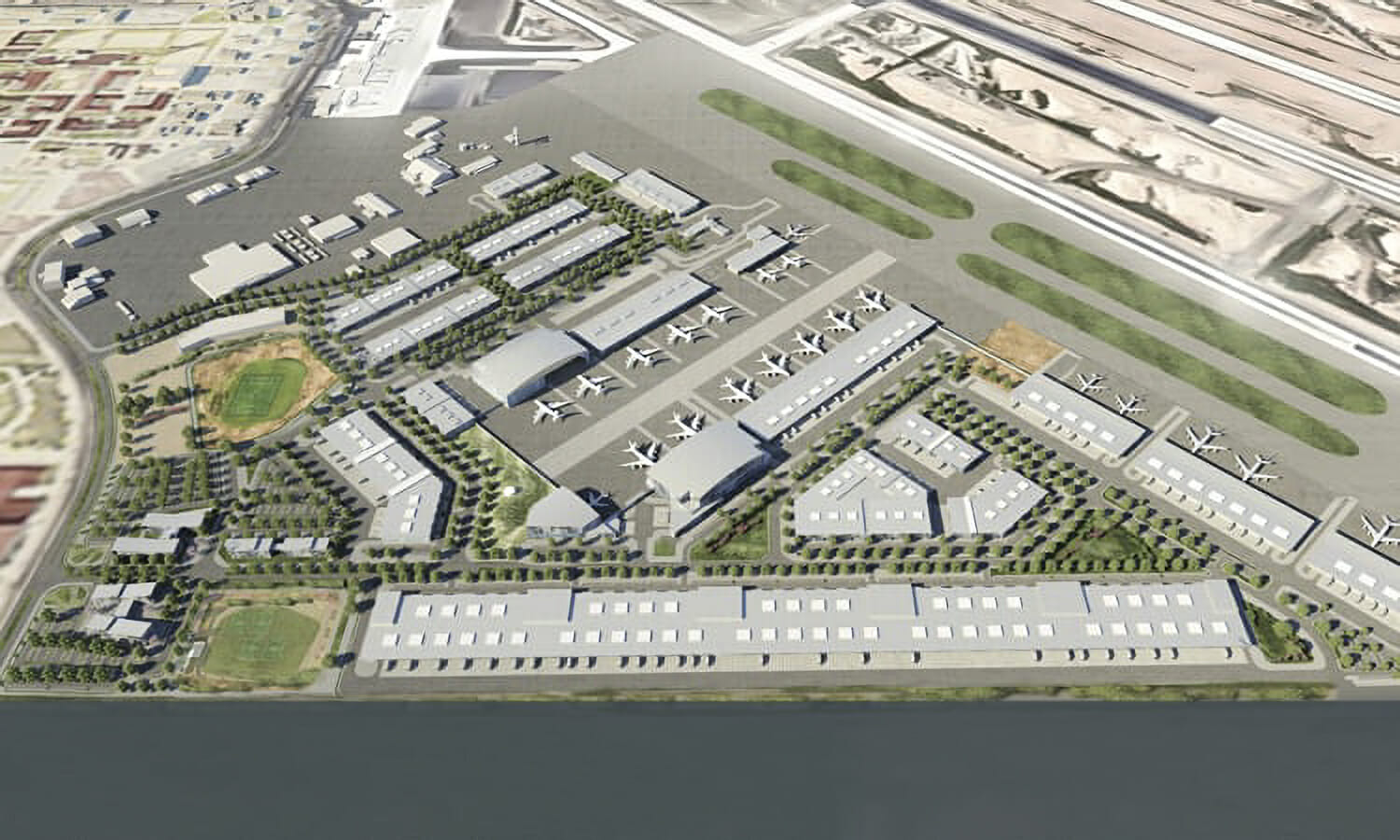Located on the southeastern edge of the Valley, the Phoenix-Mesa Gateway Airport has been a magnet for development, with the City of Mesa’s nearby Elliot Road Technology Corridor and Pecos Advanced Manufacturing Zone attracting millions of square feet of development to the area. Adding to the region’s economic vitality is SkyBridge, a 350-plus acre project that offers users the nation’s first air cargo hub with a joint U.S.-Mexico Customs inspections facility.
DEEPER DIVE: Phoenix ranks No. 2 for most industrial real estate under construction
“Five years ago, the Phoenix-Mesa Gateway Airport Authority (PMGAA) was looking for a partner to develop 350 acres down on the south end of the airport,” explains J. Brian O’Neill, executive director and CEO of PMGAA. “We were looking for someone that not only shared our vision for development but had the resources to unlock the potential of this site.”
On Feb. 21, a groundbreaking ceremony was held for Building 109, the first of two 250,000-square-foot, Class A manufacturing and logistics facilities that SkyBridge Arizona plans to break ground on during the first half of 2023. Overall, the development is slated for 1.3 million square feet of tarmac-adjacent development, nearly 2.2 million square feet of non-aeronautical space and 270,000 square feet of commercial retail, office facilities and a hotel.
“Every time we have a groundbreaking here at SkyBridge, it represents jobs and further economic sustainability in the region,” O’Neill continues. “And every time we have a ribbon cutting, it represents a different set of jobs. Whether it’s an industrial building, hangar, a hotel or commercial retail infrastructure, every [groundbreaking and ribbon cutting] validates that we picked the right partner to develop this project.”
Cleared for takeoff
One of SkyBridge’s most valuable assets is its access to the Phoenix-Mesa Gateway Airport’s runway. Rusty Martin, general manager of Graycor’s Southwest division, has been involved in the project since the first phase, having already delivered 134,500 square feet of space across two buildings, including a Class A hangar with offices and four bays to accommodate aircraft as large as a G650 business jet.
“There are a couple of unique things to [building a hangar],” Martin says. “First, they’re typically a metal structure that was designed and prefabricated off site, then brought in pieces. We build the slab then the subcontractor erects the building. In a typical warehouse, we tilt up concrete walls off the floor.”
Hangars, Martin continues, are not marketed by square footage, but by the size of aircraft that will fit inside. The structures Graycor has already built at SkyBridge can hold the largest class of corporate jets and need huge doors to accommodate the size of the aircraft.
“These doors part in the middle and track back along the interior wall on something like a train track that’s embedded in the concrete,” he says. “There’s a lot of logistics around ordering, sizing and making sure the hangar doors function correctly, because they’re large and heavy.”
Logistics in general are a challenge because the jobsite is an active airport. Martin notes that there are “secure” and “non-secure” sides of the fence that encloses the tarmac with different requirements workers must follow.
“In this case, we took the secure perimeter fence and moved it about 50 feet onto the existing tarmac so all our construction could be on the non-secure side in a somewhat normal process,” Martin says. “If anybody needed to go on the secure side, our superintendents and onsite staff had security badges to escort people.”
When cranes were necessary for part of the job, the airport and the Federal Aviation Administration (FAA) had to be notified beforehand for approval. Paperwork needed to be filed and the control tower had the power to overrule the construction schedule, but Martin notes that his team never experienced that with this project.
The most critical element of working so close to an active tarmac was to ensure that no construction debris crossed over onto the runway.
“Construction sites generate a lot of trash, so it was constant daily policing of the site and making sure that trash was put in our dumpsters so it wouldn’t blow around,” Martin notes.
Landing at Phoenix-Mesa Gateway Airport
SkyBridge is bringing the nation’s first inland joint U.S.-Mexico Customs inspections facility to Phoenix-Mesa Gateway Airport, known as the Unified Cargo Processing (UCP) program. There are 12 ports along the U.S.-Mexico border where the UCP is in effect, but Will Moseley, general manager for SkyBridge Arizona, says that SkyBridge will be the first to offer the program in the U.S. interior.
“The concept is that cargo can be cleared simultaneously by U.S. [Customs and Border Protection (CBP)] and Mexican customs, then depart Mesa Gateway as a domestic client and land in Mexico to disperse its products,” he explains. “You can literally put [the products] in the back of a truck from there and take it to the end user.”
Without the UCP program, cargo typically flies to one of a small handful of airports in Mexico — Mexico City being one of them — where it goes through the customs process before being warehoused and eventually sent to its intended destination.
“There can be two or three weeks or processing time before the cargo is dispersed. This eliminates that lag,” he continues. “And it goes directly to the customer in Sonora as opposed to Mexico City first, where it gets trucked or flown back up. [The UCP program] should expedite the process and should reduce costs once it’s fully operational.”
At first, the program will only clear cargo leaving the U.S. for Mexico, but Moseley believes that it will grow to include shipments bound for the U.S. as well.
“Empty flights coming back to the U.S. are not good, so there should be a reciprocal load coming back,” he concludes. “Right now, the program is between U.S. and Mexico, but a logical extension would be for other countries in Central and South America, and I don’t know why Canada couldn’t take advantage of this at some point either.”




